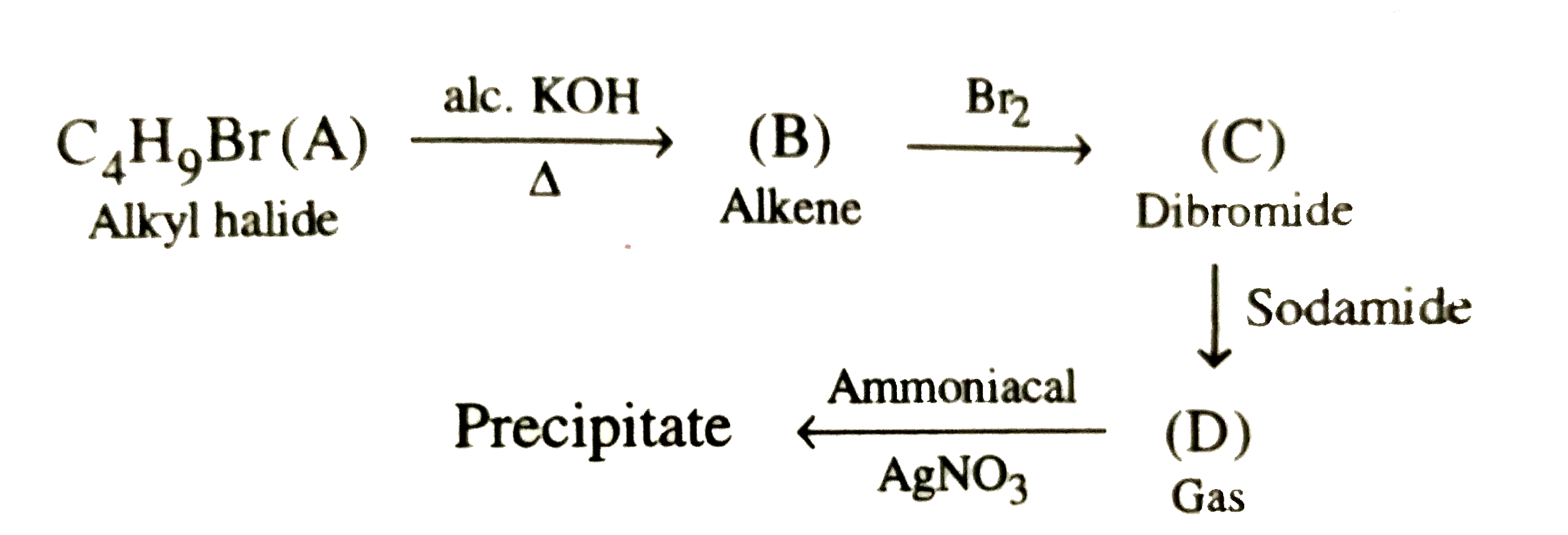Primary alkyl halide C4H9Br (a) reacted with alcoholic KOH to give compound (b). Compound (b) is reacted with HBr to give (c) which is an isomer of (a). When (a) is reacted with sodium metal it gives compound (d), C8H18 which is different from the compound formed when n-butyl bromide is reacted with sodium. Give the structural formula of (a) and write the equations for all the reactions.
According to the question ,

(i)Since the alkyl halide , C4H9Br (A) on treatment with alcoholic KOH gives an alkene (B) which on subsequent treatment with Br2 gives the dibromide (C ) , therefore , the molecular formula of alkene (E) must be C4H8 and that of dibromide (C ) must be C4H8Br2.
Now since the dibromide , C4H8Br2 (C ) on treatment with sodamide gives the gas (D), (D) must be an alkyne with the molecular formula , C4H6.
Further since the alkyne C4H6 (D) gives precipitate with ammoniacal silver nitrate solution, it must be a terminal alkyne. The only terminal alkyne possible for the molecular formula, C4H6 is 1-butyne , i.e., CH3CH2−C≡CH1-Butyne (D)
(ii)Since 1-butyne (D) is obtained by dehydrobromination of dibromide (C ) with sodamide, (C) must be 1,2-dibromobutane i.e.,
CH3−CH2−CHBr−CH2Br1,2-Dibromobutane (C)
(iii)Since the dibromide (C ) is obtained by addition of Br2 to alkene (B), (B) must 1-butene, i.e.,
CH3−CH2−CH=CH21-Butene (B)
(iv)Since 1-butene is obtained by dehydrobromination of alkyl halide (A) with alcoholic KOH , (A) must be 1-bromobutane or n-butyl bromide , i.e.,
CH3−CH2−CH2−CH2−Br1-Bromobutane (A)
(v) All the reactions cited in the question may now be explained as follows :

Thus , (A) is 1-bromobutane, (B) is 1-butene, (C) is 1,2-dibromobutane and (D) is 1-butyne.
Topper's Solved these Questions
- HYDROCARBONSBook:PRADEEPChapter:HYDROCARBONSExercise:PROBLEMS FOR PRACTICE
Explore 3 Videos
- HYDROCARBONSBook:PRADEEPChapter:HYDROCARBONSExercise:TEST YOUR GRIP (MULTIPLE CHOICE )
Explore 26 Videos
- HYDROCARBONSBook:PRADEEPChapter:HYDROCARBONSExercise:CURIOSITY QUESTIONS
Explore 4 Videos
- EQUILIBRIUM IN PHYSICAL AND CHEMICAL PROCESSESBook:PRADEEPChapter:EQUILIBRIUM IN PHYSICAL AND CHEMICAL PROCESSESExercise:Competition Focus (Jee(Main and advanced)/Medical Entrance) VIII. ASSERTION - REASON TYPE QUESTIONS (TYPE - II)
Explore 10 Videos
- HYDROGEN Book:PRADEEPChapter:HYDROGEN Exercise:COMPETITION FOCUS (Assertion-Reason Type Questions) Type 2
Explore 15 Videos
Similar Questions
Primary alkyl halide C4H9Br (a) reacted with alcoholic KOH to give compound (b). Compound (b) is reacted with HBr to give (c) which is an isomer of (a). When (a) is reacted with sodium metal, it gives a compound (d), C8H18 which is different from the compound formed when n-butyl bromide is reacted with sodium. Give the structural formula of (a) and write the equations for all the reactions.
View SolutionPrimary alkyl halide C4H9Br (a) reacted with alcoholic KOH to give compound (b). Compound (b) is reacted with HBr to give (c) which is an isomer of (a). When (a) is reacted with sodium metal it gives compound (d), C8H18 which is different from the compound formed when n-butyl bromide is reacted with sodium. Give the structural formula of (a) and write the equations for all the reactions.
View Solution
Knowledge Check
Primary alkyl halide C4H9Br (X) reacts with alc. KOH to give compound (Y). (Y) reacts with HBr to give compound (Z) which is an isomer of (X). When (X) reacts with Na metal it gives compound (P). (X), (Y), (Z) and (P) are
A X Y Z PCH3−CH∣CH3−CH2BrCH3−C∣CH3=CH2CH3−Br∣C∣CH3−CH3C8P18B X Y Z PCH3CH2CH2CH2BrCH3CH=CHCH3CH3−CH∣Br−CH2CH3C5H10C X Y Z PCH3−CH∣Br−CH2CH3CH3CH=CHCH3CH3CH2CH2CH2BrC7H14D X Y Z PCH3−CH∣CH3−CH2BrCH3CH=CHCH3CH3−CH∣Br−CH2CH3C6H12An organic compound A reacts with PCl5 to give compound B. Compound B reacts with Na/ether to give n-butane. What are compounds A and B ?
AC2H5OH and C2H5ClBC2H5Cl and C2H5ONaCC3H7OH and C3H7ClDC4H9OH and C4H9Cl
Primary alkyl halide (a) C4H9Br was reacted with alcoholic KOH to ive compound (b). Compound (b) was reacted with HBr to give (c) which was an isomer of (a). When (a) was reacted with sodium metal, it have a compound (d) C8H18, that was different than the compound when n-butyl bromide was reacted with sodium. give the structural formula of (a) and write the equations for all the reactions.
View SolutionIodoform gives a precipitate with AgNO3 on heating while CHCl3 does not. ?
Why ?
View SolutionPrimary alkyl halide C4H9Br (A) is reacted with alcoholic KOH to give compound (B). The ompound (B) is reacted with HBr to give (C) which is an isomer of compound (A). Write the structures of the compounds (A), (B) and (C).
View SolutionPrimary alkyl halide C4H9Br (a) reacted with alcoholic KOH to give compound (b). Compound (b) is reacted with HBr to give (c) which is an isomer of (a). When (a) is reacted with sodium metal it gives compound (d), C8H18 which is different from the compound formed when n-butyl bromide is reacted with sodium. Give the structural formula of (a) and write the equations for all the reactions.
View SolutionAn organic compound A reacts with PCl5 to give compound B. Compound B reacts with Na/ether to give n-butane. What are compounds A and B ?
View SolutionAn organic compound A (C2H6O) reacts with sodium to form a compound B with the evolution of H2 and gives a yellow compound C on reacting with iodine and NaOH. When heated with conc. H2SO4 at 413 K, it gives a compound D (C4H10O) which on reaction wiht conc. HI at 373 K gives compound E. The compound D is also obtained when B is heated with E. Idntify the compounds A,B,C,D and E write the equations for the reaction involved.
View Solution